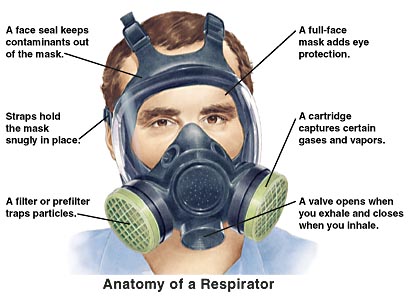Understanding Respirators
Understanding Respirators

To get the best protection from a respirator, you need to learn about its different parts. When used, maintained, and replaced the right way, the parts of a respirator can lessen your exposure to nearby hazards.
Filtering out the hazards
Cartridges trap gases and vapors. Filters trap particles. All cartridges, filters, and prefilters must be certified by NIOSH (National Institute for Occupational Safety and Health). NIOSH rates filters on a scale of 3 efficiency levels. These are 95%, 99%, and 99.97%. Within these efficiency levels are 3 filter types. These are N, R, and P. This classification refers to how effective a filter works when exposed to oils:
-
N filters. These are used when there are no oily particles.
-
R filters. These can be used to protect against oily particles. They are somewhat resistant to oils.
-
P filters. These provide the highest level of safety against all particles. They are strongly resistant to oils.
When to replace filters and cartridges
Follow instructions from your supervisor or the respirator manufacturer to learn when to replace your prefilter, filter, or cartridge.
Updated:
March 15, 2019
Reviewed By:
Horowitz, Diane MD,Horowitz, Diane, MD